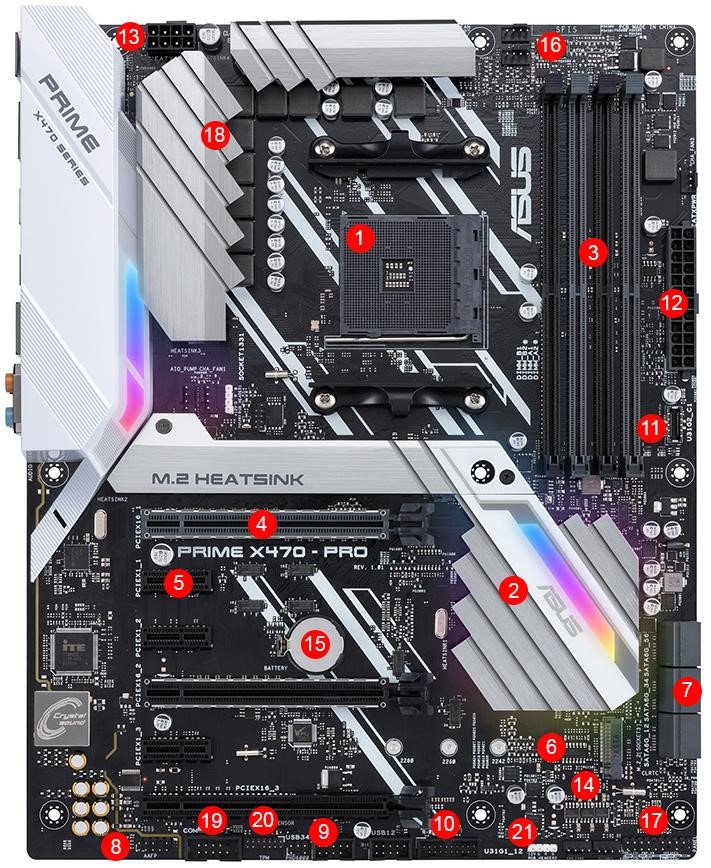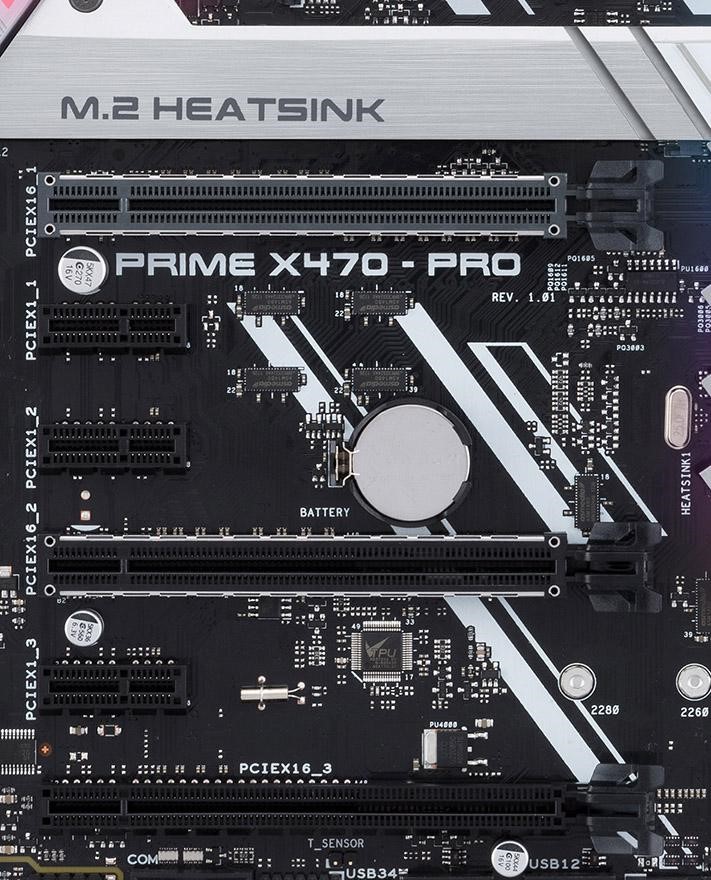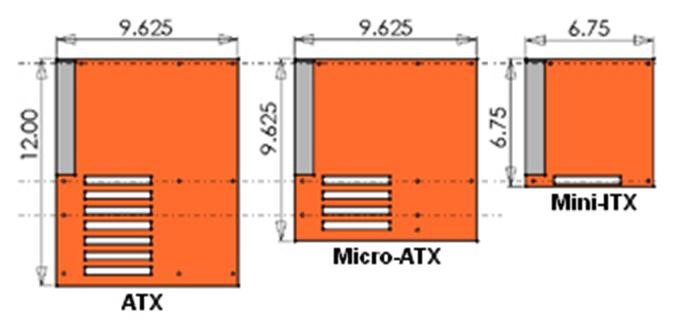Dissecting the Modern Motherboard: Connectors, Ports & Chipsets Explained
If you don’t know exactly what you’re looking at, motherboards—particularly high-end models—can look more like the Transformers’ home world of Cybertron than something you might plug your drives, CPU, and graphics cards into. And with dozens of models available for most platforms, unless you’re up on all the lingo and the latest tech, it can be tough to know where to start.
Below we’ll diagram most of the major ports, headers, and slots common on today’s motherboards, followed by some helpful basics about expansion slots, RAM, and motherboard form factors. For more detailed advice, check out our motherboard buying guide.
Motherboard Diagram
Let’s take a look at a typical higher level motherboard for an example of connector and port types. We chose the Asus Prime X470-Pro for its inclusion of many modern motherboard features, and its contrasting color design, which makes it easier to see smaller board components.

| 1. CPU socket | 2. Chipset | 3. DIMM/RAM slots |
| 4. PCIe x16 slot | 5. PCI x1 slot | 6. M.2 connector |
| 7. SATA ports | 8. Front panel connectors | 9. USB 2. header |
| 10. USB 3.1 Gen1 header | 11. USB 3.1 Gen2 header | 12. ATX power connector |
| 13. CPU power connector | 14. BIOS chips | 15. CMOS battery |
| 16. Fan headers | 17. Front panel header | 18. VRM heatsink |
| 19. COM/Serial header | 20. TPM header | 21. RGB header |
Above we’ve illustrated many of the common motherboard port and connector types. Of course, not all boards feature all types, and things like fan headers, M.2 connectors, and the BIOS battery will be located in different spots on different boards.
Also note that the M.2 connector (#6 in our diagram above) may have up to four PCIe 3.0 or 2.0 lanes feeding to it. Today’s fastest NVMe drives utilize four PCIe lanes for maximum speed, but some (like MyDigitalSSD’s SBX drives) use just two lanes to hit lower price points while still being much faster than SATA drives.
Alternatively, an M.2 slot may only connect to SATA lanes/drives, or it may support both SATA and NVMe/PCIe drives. So be sure to check what the board’s M.2 connectors are capable of before buying a drive. For more about fast storage, be sure to check out our SSD buying guide.
Expansion Slots
These days, most motherboards feature just two slot types: the long PCIe x16 and the short PCIe x1 slot. You may occasionally see an x4 slot (which sits between those two in length, but they’re pretty rare. And since you can install an x4 or an x1 card into an x16 slot, x4 slots aren’t all that useful unless you’re holding on to an old expansion card (that somehow has modern drivers) and you want to use your x16 slots for graphics cards.
Get Tom's Hardware's best news and in-depth reviews, straight to your inbox.

Note that some PCIe slots may be wired for fewer lanes than the slot length suggests, or have some lanes disabled depending on what other slots or fast drives are installed. Also know that slot arrangement/spacing is key if installing more than one or two expansion cards. In the image above, if you install a gaming graphics card (the vast majority of which are at least two slots tall) in either of the two x16 slots, the shorter x1 slots below them will be blocked. So while there are six slots on the board here, if you install two graphics cards, you’ll have just two accessible slots to add other cards.
If you are planning on installing lots of expansion cards, you’ll want to opt for an ATX motherboard (if not an E-ATX model), as smaller form factors have less room for slots (as well as other features that take up lots of PCB space). Even if a smaller board has all the slots and ports you need now, it’s good to have some left over for future upgrades.
Lastly, a note about metal-wrapped PCIe slots: These are increasingly common in high-end and even mainstream boards. The idea is that they provide more support for large graphics cards, to keep the plastic slot from cracking or outright breaking under the weight of heavy cards. We have seen slots break before--usually when large cards are installed in a system that’s been shipped across the country. But unless you are going to ship your system, or plan to cart it to LAN parties and you have a very big, heavy card, metal slots are more for show than a necessity.
Memory
Mini-ITX motherboards are usually limited to two RAM slots due to board space constraints. Some low-end chipsets are also limited to two slots, because only one DIMM per channel is supported. If you need more, you’ll need to opt for a board with at least four DIMM slots. Many boards based around high-end chipsets (X399/Threadripper for AMD and X299/Core X for Intel) have eight slots (and support quad-channel memory for more bandwidth).
That said, for most mainstream tasks (including gaming) 16GB is good enough and 32GB is ample. And the availability of 16GB modules means you can install 32GB of RAM on even a tiny Mini-ITX board--though you will pay a price premium for that extra density versus opting for a RAM kit that spreads the 32GB across four sticks.
Rear Ports

| 22. PS/2 Keyboard/Mouse port | 23. USB 3.0/3.1 Gen1 ports |
| 24. DisplayPort | 25. HDMI port |
| 26. USB Type-C | 27. USB 3.1 Gen2 |
| 28. Ethernet port | 29. Analogue/digital audio ports |
One thing to know about USB ports is that color isn’t consistent. USB 3 ports are usually blue and USB 2.0 ports black, but that’s not always the case--especially when board makers add feature like sleep-charge to some ports. Likewise, the USB 3.1 Gen2 ports on the board above are a blue-green shade, while MSI often makes its USB 3.1 Gen1 and Gen2 ports red.
Also note that, if you are planning on installing a dedicated graphics card, you likely won’t be using the on-board video ports. If that’s your aim, look for a board with fewer (or no) video ports, to make room for more USB or other ports.
Form Factor
If you’re overwhelmed by all the features and details above, you’ll be relieved to hear that, when it comes to motherboard size, your options are pretty simple. The vast majority of today’s consumer motherboards come in one of three sizes: ATX, Micro-ATX, and Mini-ITX.

ATX is the de facto standard, and offers the most space for features and expansion. Mini-ITX allows for compact PCs that still have space for one graphics card, while Micro-ATX splits the difference in both size and expansion.
You may also run across E-ATX motherboards, which are larger than ATX, but those are primarily used in workstation systems. And a tiny Mini-STX form factor (5.5x5.7 inches) also exists, but is extremely rare. As of this writing, Newegg was selling a single Mini-STX motherboard from ASRock. Chances are, you’re going to be opting for one of the three sizes illustrated above.
Chipset/Socket
Another key board consideration is, of course, what CPU you need it to support. For all you need to know about choosing a processor, you can head to our CPU buying guide. But once you’ve settled on a CPU, you often still have chipset options which dictate things like how many high-speed components you can install, or how many super-fast USB ports are supported.
Since the chipset is arguably the main component that’s permanently attached to the motherboard (as opposed to removable CPU or RAM), we’ll list the primary features of each current-generation chipset below, to help you choose. But chipsets can be incredibly complex, enough so that a story could be written about each one. Along those lines, you can peruse the finer details of Intel’s latest mainstream H370 and B370 chipsets and boards in our Cheap Coffee Lake feature. For feature details and comparisons of those and other current chipsets, you can check the charts below.
AMD Chipsets
| AMD | Chipset | PCI Express Graphics | USB 3.1 G2 + 3.1 G1 + 2.0 | SATA + NVME | SATA RAID | SupportsOverclocking |
| Enthusiast | X399 | 3x16+1x8, 2x16+3x8, 1x16+5x8 | 2+14+6 | 12 + 3 | 0,1, 10 | Yes |
| Enthusiast | X470 | 1x16/2x8 (AMD Ryzen processors) 1x8 (A-Series/AMD Athlon processors) | 2+10+6 | 6 + x2 NVMe (or 4 SATA plus 1 x4 NVMe on AMD Ryzen™ Processor) | 0,1,10 | Yes |
| Enthusiast | X370 | 1x16/2x8 (AMD Ryzen) 1x8 (A-Series/AMD Athlon) | 2+10+6 | 6 + x2 NVMe (or 4 SATA plus 1 x4 NVMe on AMD Ryzen™ Processor) | 0,1,10 | Yes |
| Performance | B350 | 1x16(AMD Ryzen)1x8 (A-Series/AMD Athlon) | 2+6+6 | 4 + x2 NVMe (or 2 SATA 1 x4 NVMe on AMD Ryzen™ Processor) | 0,1,10 | Yes |
| Mainstream | A320 | 1x16 (AMD Ryzen) 1x8 (A-Series/AMD Athlon) | 1+6+6 | 4 + x2 NVMe (or 2 SATA 1 x4 NVMe on AMD Ryzen™ Processor) | 0,1,10 | No |
| SFF Options | X300 | 1x16/2x8 (AMD Ryzen) 1x8 (A-Series/AMD Athlon) | 0+4+0 | 2 + x2 NVMe (or 1 x4 NVMe on AMD Ryzen™ Processor) | 0,1 | Yes |
| Row 7 - Cell 0 | A300 | 1x16 (AMD Ryzen) 1x8 (A-Series/AMD Athlon) | 0+4+0 | 2 + x2 NVMe (or 1 x4 NVMe on AMD Ryzen™ Processor) | 0,1 | No |
Intel Chipsets
| Intel | Chipset | Supported Processor PCI Express Port Configurations | USB Revision | Max Number of SATA 6.0 Gb/s Ports | Intel Optane Memory Support | Supports Overclocking |
| Enthusiast | X299 | Depends on CPU Model | 3.0/2.0 | 8 | Yes | Yes |
| Enthusiast | Z370 | 1x16 or 2x8 or 1x8+2x4 | 3.0/2.0 | 6 | Yes | Yes |
| Mainstream | H370 | 1x16 | 3.1/2.0 | 6 | Yes | No |
| Mainstream | Q370 | 1x16 or 2x8 or 1x8+2x4 | 3.1/2.0 | 6 | Yes | No |
| Mainstream | B360 | 1x16 | 3.1/2.0 | 6 | Yes | No |
| Mainstream | H310 | 1x16 | 3.1/2.0 | 4 | No | No |
One thing that’s important to note about chipset features: Just because something is supported by the chipset, doesn’t mean the motherboard maker has implemented it on a given board. For example, Intel’s Z370 chipset supports up to 10 USB 3.0 ports (and 14 in total), but most boards ship with 4-8 USB ports. And the newer H370 chipset features up to four faster USB 3.1 Gen2 ports, but the Gigabyte H370N WiFi motherboard lacks any of those speedy next-gen ports. In other words, sure to check the box or specs page of a board you’re interested in to make sure it has the features you’re after.
MORE: Best Motherboards
MORE: How To Choose A Motherboard
MORE: 8 Features You Probably Don't Need on a Motherboard
MORE: All Motherboard Content
After a rough start with the Mattel Aquarius as a child, Matt built his first PC in the late 1990s and ventured into mild PC modding in the early 2000s. He’s spent the last 15 years covering emerging technology for Smithsonian, Popular Science, and Consumer Reports, while testing components and PCs for Computer Shopper, PCMag and Digital Trends.
-
WINTERLORD and the build up to the release of the z390 intensifies... not that it looks all that great over z370, tomshardware must have a special review in the works.Reply -
alisamenna Correction needed within the last paragraph under "Expansion Slots"Reply
"Lastly, a note about metal-wrapped PCIe slots: These are increasingly common in high-end and even mainstream boards. The idea is that they provide more support for large memory cards, to keep the plastic slot from cracking or outright breaking under the weight of heavy cards."
*The idea is that they provide more support for large *graphics* cards* -
mlee 2500 You know what's funny? The "PS2 Keyboard/Mouse Port".Reply
It just keeps hanging around...year after year, decade after decade.... -
1budlite This motherboard has an surprising and unusual COM/Serial header. Is this header for any external com/Serial device? Is an adapter included with the motherboard? If not where can one buy the adapter for it? You have done well here, thanks.Reply -
CountMike "You know what's funny? The "PS2 Keyboard/Mouse Port".Reply
It just keeps hanging around...year after year, decade after decade...."
It's a result of too many custom and/or wireless KBs not completely compatible with BIOS at default. Also indispensable for troubleshooting/installing an OS that doesn't have native chipset or USB drivers. -
anbello262 The ps2 is also still preferred by some fps gamers, since the "less input lag" phrase is still hanging around. I do not knlw if it's true or not, I just nnow it's still common to claim it is.Reply -
desertrat76 I have built my own since DOS, learning from forums like Tom's HW. Thank you for writing a concise yet understandable article with many photographs.Reply
